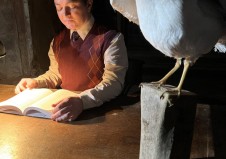An Evening with Larissa Sansour

Nation Estate, by Larissa Sansour
The UCLA Film & Television Archive and Los Angeles Filmforum present
Science Fiction Against the Margins:
An Evening with Larissa Sansour
Saturday December 14, 2024, 7:30pm
At the Billy Wilder Theater at the Hammer Museum, 10899 Wilshire Blvd, Los Angeles, CA 90024
More info at: https://www.cinema.ucla.edu/events/2024/12/14/science-fiction-shorts-larissa-sansour-soren-lind
In-person:
Q&As with filmmaker Larissa Sansour (before and after "Familiar Phantoms"); author and UCLA School of Theater, Film and Television Distinguished Professor Chon Noriega.
Admission is free. No advance reservations. Your seat will be assigned to you when you pick up your ticket at the box office. Seats are assigned on a first come, first served basis. The box office opens one hour before the event.
Special thanks to our community partners: Los Angeles Filmforum.
Part of Science Fiction Against the Margins.
Born in East Jerusalem, Palestine, and currently based in London, interdisciplinary artist Larissa Sansour creates works that examine the collective memory and trauma of the Palestinian people through allegorical and experimental science fiction films. Sansour works closely with her partner, Danish filmmaker and writer Søren Lind, co-directing and writing most of their films. Their works can be comical and/or dark, but always speak to the current political climate and push against unquestioned mainstream narratives. Our closing night screening includes the three films in Sansour’s science fiction trilogy — A Space Exodus (2009), Nation Estate (2013) and In the Future They Ate From the Finest Porcelain (2015) — along with her follow-up science fiction film In Vitro (2019). Though varied in aesthetic and approach, the films relate to one another in their examination of inherited history and identity, trauma and resistance.
Larissa Sansour works mainly with film, and also produces installations, photos and sculptures. Central to her work is the dialectics between myth and historical narrative. Her work often uses science fiction to address social and political issues, dealing with memory, inherited traumas, power structures and nation states.
In 2020, Sansour was the recipient of the Jarman award. Her work is shown in film festivals and museums worldwide amongst which, the Tate Modern, MoMA, Centre Pompidou and the Istanbul Biennial. In 2019, Sansour represented Denmark at the 58th Venice Biennale. Her current solo shows in 2024 are Indigo is the Colour of Grief at Göteborgs Konsthall in Sweden and a retrospective of her work at Amos Rex Musuem in Helsinki, Finland. She lives and works in London in the UK.
Notes by Nicole Ucedo
Science Fiction Against the Margins showcases filmmakers who occupy the “margins” of mainstream cinema in order to challenge and subvert the science fiction genre. Hollywood’s ubiquitous sci-fi story structure functions within the conventions of action-driven melodrama, resolving social issues in private, emotional and moral terms that reinforce the status quo. This series offers an alternative body of media wherein a speculative mode of thinking outside familiar expectations of narrative resolution opens up representations of race and ethnicity, gender politics and cultural identity. While the focus is on the feature film as a global form of mass entertainment, the series also includes documentaries, shorts, video art and television episodes.
The titles selected reflect a global scope, including films from various regions of the world as well as those by minority and Indigenous cultures. Central to the program is investigating how different independent and international cinemas utilize speculative fiction as a means of exposing inequality — the rationalization of authoritarian rule, capitalist exploitation of racialized labor and environmental imperialism. The series rejects the notion of an underlying “sameness” across cultures and social protests, instead bringing attention to the divergent ways in which social identity, cultural context and material relations are represented by media artists.
Science Fiction Against the Margins reimagines the relationship between science and art by challenging and sometimes finding new inspiration in old cinematic traditions. Works span the history of world cinema, including reflections on colonialism and the moon in Georges Méliès’ A Trip to the Moon (France, 1902), Nuotama Bodomo’s Afronauts (Ghana, 2014) and Yosep Anggi Noen’s The Science of Fictions (Indonesia, 2019). Several films offer speculative visions of societies struggling to overcome dictatorship, whereby the present is explained as either one of collective madness or of a planet under alien invasion, such as Man Facing Southeast (Eliseo Subiela, 1986). In other films, the future presages the total privatization of critical resources supporting human existence, envisioning an endgame brought about by forced labor, political subjugation and environmental collapse, as in Sleep Dealer (Alex Rivera, 2008), Pumzi (Wanuri Kahiu, 2009) and Neptune Frost (Saul Williams, Anisia Uzeyman, 2021). Overall, the series explores an alternative mode of science fiction that raises critical questions rather than offering comforting answers.
—Science Fiction Against the Margins Curatorial Team: Paul Malcolm, Maya Montañez Smukler, Chon Noriega, Nicole Ucedo
Science Fiction Against the Margins is part of this year’s PST ART: Art & Science Collide, presented by Getty. For more information visit pst.art.

In the Future They Ate From the Finest Porcelain
In the Future They Ate From the Finest Porcelain
U.K./Denmark/Qatar, 2015, DCP, color, in Arabic with English subtitles, 29 min. Directors: Larissa Sansour, Søren Lind. Screenwriter: Søren Lind. With: Pooneh Hajimohammadi, Anna Aldridge, Leyla Ertosun.
Guided by a therapist-like voice, a self-proclaimed “narrative terrorist” recounts her dreams. In one dream, porcelain plates adorned with the traditional Keffiyeh print gently drop from the sky until they begin to catapult down dangerously. The narrator divulges to her therapist (or interrogator?) her plan to bury the DNA-coated plates for archaeologists to find in the future, falsifying proof of a people’s past existence. Sansour combines science fiction, politics and archaeology in her third sci-fi film to allude to current practices used to prove (or disprove) a people’s existence. In still and slow-panning shots, the uncanny dystopia visualized here probes into who gets to be the narrator of history. Combining images of past and future, archival and CGI, dead and living, the film poses the question: what is the future for a people denied their past?

In Vitro
In Vitro
Denmark/Palestine/U.K., 2019, DCP, b&w, in Arabic with English subtitles, 28 min. Directors: Larissa Sansour, Søren Lind. Screenwriter: Søren Lind. With: Hiam Abbass, Maisa Abd Elhadi, Walaa Eltiti.
An eco disaster in Bethlehem reminiscent of the 1948 Nakba forces survivors out of their homes and into a new life underground. Two women meet in a bunker beneath the city’s streets. The elder of these holds lived memories while the younger’s memories were implanted. Thus, the basis for a set of arguments between two generations: Are the inherited memories as valid as lived ones? Can our identities be rooted in memories we didn’t experience firsthand; that is to say, in memories passed on by our ancestors? Originally commissioned for the 58th Venice Biennale, the two-channel black-and-white video switches focus between the younger woman, Alia, played by Maisa Abd Elhadi, and the elder Dunia, played by prolific Palestinian actor Hiam Abbass, as they discuss what can and should be rebuilt.

Nation Estate
Nation Estate
Denmark, 2013, DCP, English audio, color, 10 min. Director: Larissa Sansour. Screenwriter: Søren Lind. With: Larissa Sansour, Leila Sansour, Maxim Sansour.
Sansour’s dark sense of humor comes out most fully in Nation Estate. The film offers a solution to the deadlock in the Middle East: permit Palestinian statehood within a skyscraper, the Nation Estate. By stacking one Palestinian city on top of another — one floor for Jerusalem, one for Sansour’s childhood home of Bethlehem, etc. — the fight for land is no longer an issue. Vertical living allows Palestinians to access their cultural landmarks via elevator without getting in the way of the rulers. Luxury living and freedom are packaged into a controlled and constrained environment. A pregnant woman stares out the Nation Estate window at the real Al-Aqsa. The film induces a sad chuckle.

A Space Exodus
A Space Exodus
Denmark/Palestine, 2009, DCP, English audio, color, 5 min. Director/Screenwriter: Larissa Sansour. With: Larissa Sansour.
Perhaps Sansour’s most pointed work, A Space Exodus shows a Palestinian astronaut reaching the moon through recreated scenes from the first moon landing and Stanley Kubrick’s 1968 film 2001: A Space Odyssey. The theme from 2001, Richard Strauss’ “Also sprach Zarathustra,” signals the event as recognizable, but when arabesque sounds join the melody, the juxtaposition between image and sound is brought to the foreground. As the astronaut (Sansour herself) plants the Palestinian flag on the moon, the orator back on Earth says, “a small step for a Palestinian, a giant leap for mankind.” This satirical film’s iconic images frame the colonization of outer space in a nonsensical manner as our astronaut floats off farther and farther from the call to Jerusalem.

Familiar Phantoms
Familiar Phantoms
U.S. Premiere!
U.K./Palestine, 2023, DCP, color, in Arabic with English subtitles, 40 min. Directors: Larissa Sansour, Søren Lind. Screenwriter: Søren Lind. With: Sofia Asir, Sofie Baldgiev, Leila Sansour, Maxim Sansour.
“I know far too well that memory is a rogue agent.”—Familiar Phantoms
Familiar Phantoms is the most personal project yet for Larissa Sansour who co-directed the film with her partner Søren Lind, the film’s screenwriter. Revisiting family anecdotes, objects and spaces, Familiar Phantoms considers what it means to remember, and what it means to remember something that didn’t happen to you. Told through theatrically staged vignettes starring Sansour’s siblings as her father and aunt (Maxim Sansour and Leila Sansour), the recreated scenes attempt to bring life to tales Sansour was told as a child. Though vibrant in color, the memories are just as cloudy as anything else we’re told as children, at times debunked when conflicting facts and dates are proven.
The film combines Super 8 archival footage from Sansour’s childhood in Bethlehem with the sharp reenacted scenes and ghostly moving shots down a large home’s hallways and rooms — the stand-in for their family home in Bethlehem. The film switches between full screen to dual screen, making visual connections between the past and present. Sansour searches for explanations for the loss of a home in Palestine through clues in the family objects that remain, and the home movies shot by her parents. Self-reflective in form, Familiar Phantoms winds the viewer through the stages of remembering, forgetting and searching for meaning in what’s left. Whenever Sansour leaves Bethlehem, she has the feeling that she’s left something behind.
